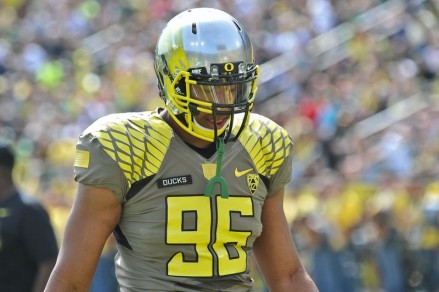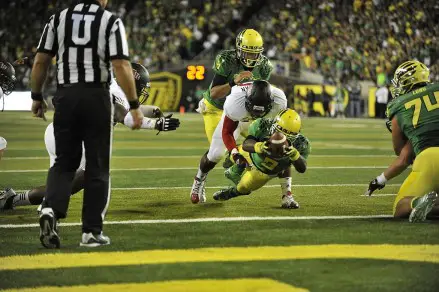True freshman make it on to the field every season in college football and just about every team finds one that they expect to become a big impact player. Barring injuries or off-the-field issues, many of those players find themselves a starting position by their sophomore year assuming the depth chart ahead of them isn’t loaded.
Ifo Ekpre-Olomu played well as a true freshman, and as a sophomore last season locked down a starting spot at cornerback. Going into his third year at Oregon, Ekpre-Olomu is one of the most talented corners in the country and quite possibly the best.
A scenario frequently less covered involves players that play as a true freshman, then redshirted during their second year of eligibility.
Subtract injuries and off-the-field issues, it seems like blasphemy to redshirt a player that was able to work his way onto the field his first year in college. But what if a team were so experienced at a position they redshirted a true sophomore during what WOULD be his second year of play?
The first thing people would do, like they always do, is freak out. Passionate fans in any sport always go nuts before they can actually stop and think.
The story of the Ducks in 2013 entails the security of returning starters at key positions and the lack of depth at others. Defensive linemen are plentiful, but the way Oregon rotates players won’t allow for the Ducks to leave anybody out. The linebacking corp is young and will battle all season long for starting spots. Even the receiving corp, one of the most underrated units in college football, returns plenty of talent to produce.
The one glaring quandary the Ducks have this season, one that many coaches in the country would love to have, is what to do with all the talented tight ends?
The Oregon Ducks roster (pre-summer enrollees), lists five scholarship tight ends: junior Colt Lyerla (6’5″ 245 pounds), redshirt sophomore Koa Ka’ai (6’4″ 249 pounds), sophomore Terrance Daniel (6’6″ 249 pounds, sophomore Pharoah Brown (6’6″ 234 pounds) and redshirt freshman Evan Baylis (6’6″ 244 pounds).
Oregon has five freakish athletes, all 6’4″ or taller and weighing more than 230 pounds, and Johnny Mundt isn’t even on campus yet…
The Ducks should redshirt Pharoah Brown or Terrance Daniel?
There is no reason that either of these players should redshirt after proving worthy of finding the field their freshman season. One of them should redshirt because Oregon is deep at tight end and creating separation would be extremely beneficial for saving eligibility.
Behind Lyerla, Brown looked like the most impressive athlete and most capable successor. Daniel on the other hand, recorded two tackles last season and is raw on both sides of the ball. But Daniel did still see the field, and Brown obviously wasn’t capable of playing all game long.
So what will the Ducks do?
The Ducks need to have one or both of these tight ends redshirt.
Baylis came to Eugene for spring ball, but apparently couldn’t separate himself from other summer arrivals Brown and Daniel. Like Baylis, if neither of these two can really break away from the pack they should redshirt.
Daniel looks like the obvious choice given his lack of experience and playing time as a true freshman, but to say that Brown progressed significantly further than Daniel, Ka’ai or Baylis would be a stretch. Had Brown been much further along, Ka’ai wouldn’t have split time with him.
Everyone is so worried about who will switch positions they forget that maybe the plan is to try and keep them all at tight end.
But the problem is, as much as everyone wants to see it happen, Oregon doesn’t use two tight ends. A hot debate among Duck fans has always been whether or not the team had the manpower to use two tight ends.
It didn’t really happen with Paulsen and Dickson, Lyerla and Paulsen, and Lyerla and Brown or Ka’ai or Daniel won’t happen either.
Oregon can afford to force one or both to redshirt because the Ducks rarely use two tight ends anyway. While Brown or Daniel could make a big splash this year, they won’t because they won’t be on the field to get more than their feet wet.
It may seem like a traveshamockery to let either of these players redshirt, but it feels pointless to let talent like that sit on the bench, unused except for 25-point leads.
For Oregon, unless someone gets injured only three tight ends will see time, with the #1 getting easily more than 75% of the snaps. When Johnny Mundt arrives on campus, the Ducks will have six physical anomalies penciled in at ‘TE’ and letting any of them escape this traffic without a redshirt would be a waste of their time.
Mundt and Brown and/or Daniel can redshirt. Redshirting three tight ends may result in attrition, but not redshirting more than one will likely see the same result.
Related Articles:
Chip Kelly Update: Everything's Good Again ...
Chip Kelly Update: Wailing and Gnashing of Teeth
Shock and Awe -- The Oregon Ducks' Football Hangover Effect
Despite Lopsided Score, Georgia State "Never Stopped Believing"
Hope Springs Eternal for Ducks
Incompetent Pac-12 Officials: How Do You Miss ALL of THIS?
Brandon is a senior at The University of Oregon majoring in Film Studies and minoring in Communications. Brandon has been a Duck fan for ten years since he moved from southern California to Salem, Oregon, and quickly realized the Ducks were the missing piece in his life. A Pac-12 fan since birth, much of his family attended UCLA and has since converted all of them to the Quack Attack. Brandon interned for the Statesman Journal covering the Salem-Keizer Volcanoes and hopes to work for the Pac-12 in the near future. He also hopes to see the “Flying-V” formation played out on the football field in the fall of 2013. Brandon would love your feedback on any and all articles. Tweet me: @BrandonGruber




